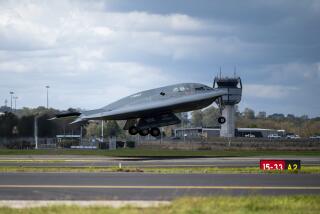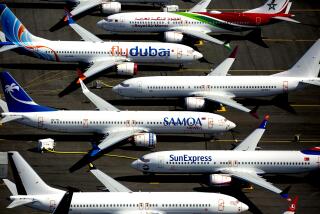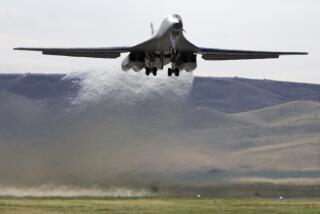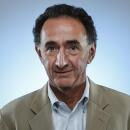Debut of Secret Plane : Stealth: It Keeps Them Guessing
- Share via
When Northrop rolls out its B-2 stealth bomber in a formal ceremony Tuesday, it will expose to the world what has been the largest secret industrial effort since the Manhattan Project that developed the atomic bomb during World War II.
Over the last decade, millions of aircraft parts have been surreptitiously produced at factories around the nation in a cloak-and-dagger world, ostensibly designed to withhold from Soviet spies the scientific details of the Air Force’s revolutionary bomber.
As part of the secrecy, the B-2 parts were sometimes shipped to phony drop locations, then taken in unmarked trucks at night to Northrop’s Pico Rivera plant, where the bomber was being developed. In many cases, subcontractors had no idea what they were producing--or for whom.
Indirect Route
Executives who visited the plant avoided flying helicopters directly to the factory, going instead to a nearby heliport and driving to the plant to escape attention. Military officers working at the plant or visiting for the day wore civilian clothes for the same reason.
Even for the normally paranoid aerospace industry, the security measures imposed on the B-2 have been unprecedented. To this day, Northrop cannot tell its owners--the public shareholders--how much money it earns on the bomber even though the project accounted for about half of its 1987 sales of $6.1 billion.
The measures have imposed a stiff price: The government has paid untold millions of dollars to keep security tight on the huge project; industrial efficiency has suffered; many employees have paid emotionally for government and corporate browbeating over security; Wall Street investors with millions of dollars at stake were never certain what was happening on the big bomber.
Raging Curiosity
The secrecy has fueled a raging curiosity about the bomber, making it an object of far greater interest than any military aircraft program in decades. Until recently, even many Northrop employees had no idea what the airplane looked like, though many tried hard to imagine.
“I would look at those tooling jigs (templates) every time I walked by them and try to figure out what the airplane looked like,” a Northrop toolmaker said in an interview last week. “I must have guessed a hundred different designs. It drove me batty.”
As is widely known by now, the B-2 stealth bomber is a flying wing--an airplane without a conventional fuselage or tail--designed to slip through enemy radar defense without being detected and then deliver up to 16 nuclear bombs.
The program to produce 132 B-2s is expected to cost $68 billion, or roughly $500 million per bomber, making it the most expensive mass-produced aircraft in history. Each B-2 will cost about the same as a fleet of 20 MD-80 passenger jetliners, or more than most skyscrapers.
By comparison, the World War II effort to develop the atomic bomb cost $2 billion, which in today’s inflated dollars would be equal to about $12 billion. Air Force officials have said in interviews that the stealth bomber is the biggest secret program since the Manhattan Project.
The Air Force started a full-scale program to develop the bomber in 1981 and had divulged almost nothing officially about the effort until this year, when some details were declassified.
Even then, it was sometimes grudging. When the Air Force released an artist’s rendering of the bomber earlier this year, it was purposely inaccurate.
Costs Considered
The decision to show the bomber publicly now was probably driven by the enormous future cost to do otherwise. The B-2 is expected to begin flying early next year, and if flight testing were to be conducted entirely in secret, it would take far longer and cost tens of millions of dollars more, a former top Pentagon official said.
Until now, the Air Force and Northrop have gone to great lengths to conceal the most minute details of the industrial effort, which involved tens of thousands of employees at major aerospace facilities all over the country.
For example, many of the B-2 production tools were secretly made in a plain, windowless building on Denker Road in Torrance and then trucked to Northrop’s big production plant in Pico Rivera. Just before the tools were shipped, however, the serial numbers on them were removed and new numbers assigned.
‘Wild Stuff’
“We were told that if somebody got the tool numbers, they’d know quite a bit about the sequencing of the production line,” the toolmaker said. “But I had never seen anything like that before. This was wild stuff.
“I saw dozens of drawings for the skin (of the bomber), but I never saw a single diagram that showed where the fuselage started, and I could never figure out how big the airplane was going to be,” he said. “I’ve been building airplane tools all my life, and I couldn’t figure this airplane out.”
Many subcontractors building parts for the B-2 were also unable to figure out the airplane. Northrop has 87 major subcontractors working on the B-2 and many more machine shops, forges and electronics producers turning out small parts.
On a few occasions, Northrop engineers suddenly turned up at small machine shops and personally supervised the production of a part, leaving at the end of the day with the part carefully concealed, according to operator of one shop.
“If you play the game with them, you get tacit confirmation that the hardware is for Pico Rivera,” he said. “But even to this day, they will not frankly admit what is obvious.”
In the early 1980s, though, procedures were even tighter. Northrop set up dummy companies that would order standard parts needed for the program and have them shipped to a dummy company’s site, called a “drop,” according to a purchasing agent at Pico Rivera and a former company manager. Then the parts were trucked into the plant at night.
At the same time, Wall Street investors could never be certain whether Northrop was on the verge of a disaster or a windfall of profits. They still do not know. As a result, the stock has suffered greatly for the uncertainty, some analysts say. The stock is trading at about $32 a share, down from a peak of $56.625 in mid-1985.
‘A Casino Play’
“Northrop is a casino play,” said securities analyst John A. Modzelewski of Paine Webber, which has nonetheless been bullish on the stock. “Northrop stock is mispriced, but it is hard to tell in what direction. Half the world says it is way underpriced, and the other half says they don’t have any idea of what it’s worth, and they aren’t willing to pay anything for it.”
Indeed, Northrop stunned Wall Street in 1986 and 1987 by taking write-offs against profits of $214 million on the B-2 program. The enormous reductions in income, coming out of the blue, eroded investor confidence more than they might have if they had been better explained.
As a result, some securities analysts resorted to their own unusual methods to learn what they could about the bomber program.
At one point, Joseph Campbell of Paine Webber became so curious about the status of the bomber program that he enlisted sources to count the number of cars in the parking lot at Northrop’s Palmdale plant, where the bomber is being assembled for flight.
“If the Central Intelligence Agency (looks) at overhead photos, then there is something to be learned by doing that,” Campbell said. “While Paine Webber is not the CIA . . . it is a starting point. I am a firm believer in the philosophy that head count tells all.”
If Wall Street was troubled by the secrecy in the bomber program, employees were doubly so. Although all employees at the Pico Rivera and Palmdale plants have security clearances, access to information about the bomber is carefully controlled by a “need to know” rule.
“People end up working with paper bags over their heads,” said a former supervisor at Pico Rivera. “People can hide their incompetence behind a shield of ‘need to know.’ ”
Make-Work Jobs
When new employees were hired, they could not go directly to work on the bomber until they had obtained their clearances. Sometimes they were assigned for weeks to make-work jobs in an area of the Pico Rivera plant known irreverently as the “drunk tank.”
The compartmentalization of work also created inefficiencies. For example, the former supervisor recalled that several of his employees worked on tasks that he was not cleared to know about himself.
“I could not ask what they were doing,” he said. “I wasn’t even supposed to know where they were working. For all I knew, they were going to the movies every day.”
Many employees at Pico Rivera are cleared to a “secret” level, and a much smaller group is cleared for “top-secret” information. Strict rules require separation of secret and top-secret work.
If a computer is used to process top-secret data, it cannot process secret or confidential data. The top-secret computers are kept in special locked vaults, reportedly lined with lead to prevent electronic data from leaking out.
When Northrop acquired a Cray Supercomputer, a battle erupted among computer workers over whether it would be a secret or a top-secret machine.
“Here was this state-of-the-art computer, and it was going to disappear into this lead-lined room that only a few engineers were going to have access to,” one data-processing employee recalled last week. “There was a big fight over it. Finally, they decided it would be only a secret machine.”
Constant Observation
To work at the Pico Rivera plant means being subjected to constant observation and rules that seem straight out of the authoritarian world of George Orwell’s “1984.”
Some employees must work at computer terminals cordoned off by black curtains to shield their work from their fellow employees. Most workers assume that telephones are monitored by management or the government.
Conference rooms approved for top-secret discussions are equipped with motion detectors and microphones, presumably to ensure that no one enters the rooms to plant bugging devices. Each such room has an official custodian, and visitors must sign in and out.
“If you see somebody in the hallway and they say: ‘Hi, what are you working on?’ you have to think: ‘Now, can I tell them or will I be breaking security?’ ” one Pico Rivera employee said. “You are always paranoid.”
Assembly-line workers in the plant faced severe demands. When the program fell behind schedule several years ago, mandatory overtime was instituted, and it took a heavy toll.
“I have been required to work 80 or 90 hours a week” for weeks at a time, one aircraft mechanic said. “I would get there at 4 a.m., and I wouldn’t leave until 8 p.m. And that would go on seven days a week. The majority of people did that in my area. I worked Christmas Day, New Year’s, July 4 and Thanksgiving. We never had weekends off.”
The secrecy tended to increase the stress. At Pico Rivera, for example, Northrop employees worked side by side with employees from major subcontractors. But the workers were not supposed to tell each other who they worked for. The companies were known only by their numbers.
“I have been intimidated big-time by this company,” said one weary worker. “I wish to God there was a union there.”
Northrop has no unions, but the company pays wages that are as high or higher than unionized aerospace companies in Los Angeles. The worker, an hourly mechanic, said he earns about $14 an hour--$3.50 an hour more than he was earning two years ago at Rockwell International on the B-1 bomber program.
The Air Force’s tough security measures succeeded in netting two spies.
Northrop engineer Thomas Patrick Cavanagh was found guilty of espionage and sentenced to life in prison in 1985 after he allegedly attempted to contact the Soviet Embassy in an attempt to sell stealth secrets.
And Hughes Aircraft engineer William H. Bell was convicted for allegedly passing information on the bomber’s secret radar system, which Hughes developed, to a Polish spy. Bell was sentenced in 1981 to eight years in federal prison.
Some Slip-Ups
But the security system did have its slip-ups. The Pentagon granted a top-secret security clearance for the stealth program to a high school dropout and convicted felon. William Albert Reinke claimed on his Northrop employment application to have attended graduate engineering school at a time when he was actually serving on a Florida chain gang. Reinke, who went to work for Northrop as an engineer, was convicted in 1986 of defrauding the government.
The General Accounting Office, an arm of Congress, also found last year that Northrop had misplaced or lost 780 classified documents on the stealth at Pico Rivera. But the GAO said it had no proof that any classified information had been compromised.
When the stealth bomber is towed out of its secure hangar in Palmdale on Tuesday, it may seem that the veil has been fully lifted. But official secrecy will continue to surround the bomber for years.
And it is not clear how well the program is going. Some employees and subcontractors in Los Angeles said the aircraft that will be rolled out is not complete. Until recent days, for example, the seats had not been installed in the cockpit, and many electronic boxes were still awaiting installation, they said.
The Air Force will probably keep people guessing about the details. At the roll-out ceremonies, visitors will be permitted to get no closer than 200 feet from the bomber and will be permitted to view the aircraft only from the front.
More to Read
Inside the business of entertainment
The Wide Shot brings you news, analysis and insights on everything from streaming wars to production — and what it all means for the future.
You may occasionally receive promotional content from the Los Angeles Times.











